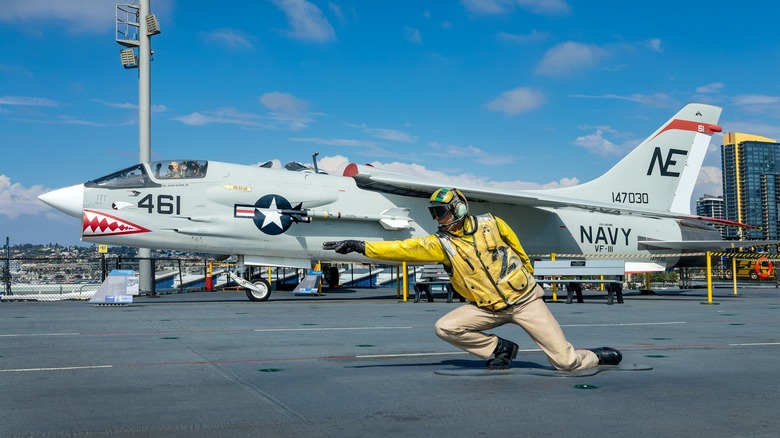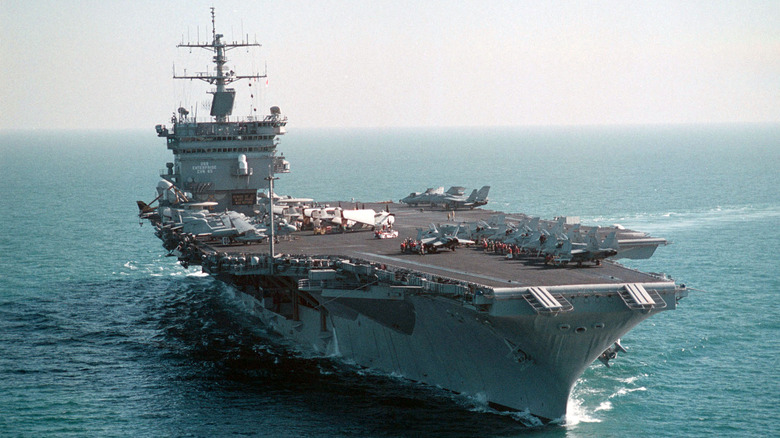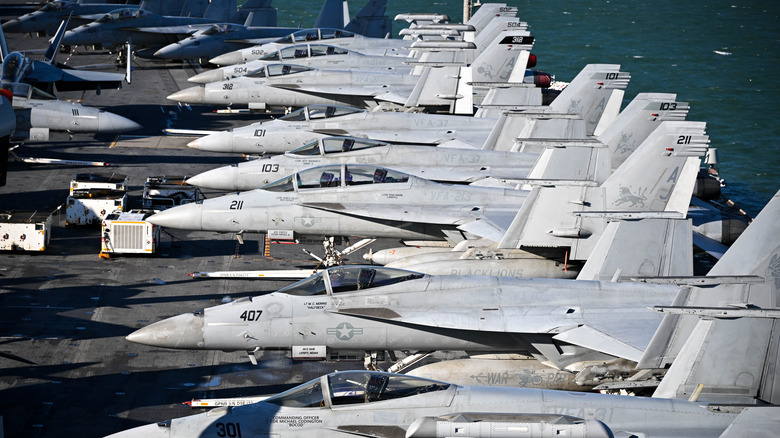WHY THE FLIGHT DECK OF AN AIRCRAFT CARRIER IS THE DANGER ZONE
There are many jobs in the United States military that are dangerous — it's the military, after all. That said, there are a few positions that are far more dangerous than others. The job at the top of the list of most dangerous in the military is working on the flight deck of an operational aircraft carrier. Kenny Loggins' hit song, "Danger Zone," which is featured in the movie "Top Gun," is all about carrier flight operations, though the term "Danger Zone" has several meanings.
Flight operations are dangerous anywhere in the world, but an aircraft carrier is very different from a small airport in the middle of nowhere. The ship itself is typically moving under its own power while it's also moved by the ocean. Most people working on the deck of an aircraft carrier aren't about to walk off the edge, but it does happen. Still, the most dangerous aspect of flight operations is dealing with the aircraft themselves. Accidents happen and have happened throughout aircraft carrier operations, and they're often deadly.
Of course, safety is on everyone's mind, given the "controlled chaos" of a carrier deck, from the officers in the tower to the pilots in their aircraft, and the men and women on the deck. Proper training and maintenance are key, but even with every precaution taken, the deck of an aircraft carrier remains one of the most dangerous places to work in the U.S. military. There's a reason it's called the Danger Zone, and each one of these accidents proves that anything can happen during flight operations on an aircraft carrier.
People occasionally fall off the flight deck
While most people know that an aircraft carrier is a gigantic naval vessel, it's hard to picture how high the flight deck is above the waves. An aircraft carrier's flight deck height varies depending on the type of carrier, but some flight decks are 60 feet above the water line. It's easy to think that falling into water saves a person some broken bones, but falling from that height into the water is a fantastic way to fracture several bones if they don't know how to properly enter the water.
Even then, broken bones can happen, so sailors take it seriously when someone goes overboard. Fortunately, it's rare, but it happens every once in a while, and it can be deadly. Not only does a falling sailor have to contend with hitting the waves from a great height, but they can be pulled under and injured or killed by the ship itself. Once it happens, it's announced that there's a "man overboard," with the direction of the fall (port or starboard).
A life ring is thrown on that side, and the ship makes an immediate course correction to try to return to where the person fell into the water. There are several ways someone can find themselves falling overboard from the flight deck, and they're all indicative of why it's so dangerous. A person can be blown overboard from a jet blast, and in one instance, a deck ejection from an aircraft had the pilot end up behind the ship. In 1965, U.S. Navy Airman Apprentice Barry Peterman was blown off the deck of the USS Enterprise (CVN-65) aircraft carrier by jet exhaust, and his body was never found.
Aircraft fall off and can injure or kill people on the flight deck
While it's rare for someone to fall off an aircraft carrier's flight deck, the same cannot be said of aircraft. Normally, all aircraft not in operation but atop the flight deck are chained down, but that doesn't always keep them there. In July 2022, the U.S. Navy lost one of its F/A-18 Super Hornets assigned to the USS Harry S. Truman (CVN-75), when it blew overboard after the ship met heavy weather in the Mediterranean. The Navy eventually recovered the aircraft, which sat 9,500 feet below the waves.
One sailor was injured during that foul weather event, but one of the most dangerous moments on the flight deck involves the recovery of aircraft. In January 2022, an F-35C Lighting II crashed while attempting to land on the USS Carl Vinson (CVN-70) during operations in the South China Sea, injuring seven sailors on the flight deck. The fighter subsequently fell overboard while in flames, and fortunately, the pilot ejected and was recovered by a rescue helicopter conducting Plane Guard duty, which always flies nearby during flight ops for just such an eventuality.
Aircraft launch and recovery operations are the most dangerous times to be on the flight deck of a carrier that's not under direct attack. Jets blast off from incredibly short runways via powered catapults; there are explosives all around and plenty of jet fuel. On October 4, 2008, aboard the USS Dwight D. Eisenhower (CVN-69), Aviation Boatswain's Mate 2nd Class Robert Lemar Robinson was killed by an aircraft during flight operations, making him one of many casualties that occurred on aircraft carrier flight decks during normal operations. These are just a few examples of why an aircraft carrier's flight deck is the U.S. military's true Danger Zone.


